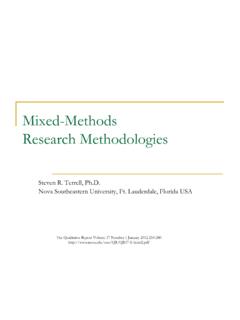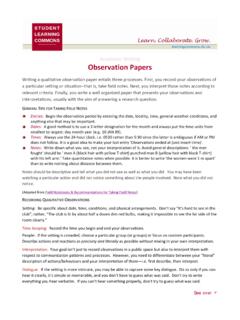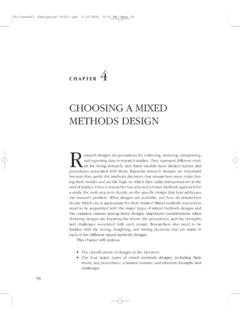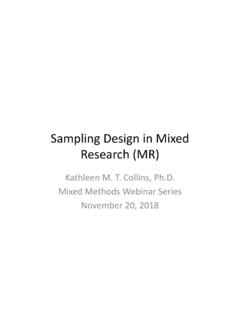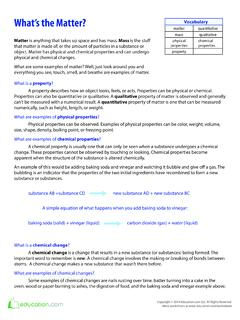Transcription of Table of Contents
1 Table of ContentsDedicationTitle PageCopyright PageAnalytic Contents of Research TechniquesPrefaceAcknowledgementsAbout the AuthorPART I-Preliminary ConsiderationsCHAPTER ONE-The Selection of a Research DesignTHE THREE TYPES OF DESIGNSTHREE COMPONENTS INVOLVED IN A DESIGNRESEARCH DESIGNS AS WORLDVIEWS, STRATEGIES, AND METHODSCRITERIA FOR SELECTING A RESEARCH DESIGNSUMMARYADDITIONAL READINGSCHAPTER TWO-Review of the LiteratureTHE RESEARCH TOPICTHE LITERATURE REVIEWSUMMARYADDITIONAL READINGSCHAPTER THREE-The Use of TheoryQUANTITATIVE THEORY USEQUALITATIVE THEORY USEMIXED METHODS THEORY USESUMMARYADDITIONAL READINGSCHAPTER FOUR-Writing Strategies and Ethical ConsiderationsWRITING THE PROPOSALWRITING IDEASETHICAL ISSUES TO ANTICIPATESUMMARYADDITIONAL READINGSPART II-Designing ResearchCHAPTER FIVE-The IntroductionTHE IMPORTANCE OF INTRODUCTIONSQUALITATIVE, quantitative .
2 AND MIXED METHODS INTRODUCTIONSA MODEL FOR AN INTRODUCTIONSUMMARYADDITIONAL READINGSCHAPTER SIX-The Purpose StatementSIGNIFICANCE AND MEANING OF A PURPOSE STATEMENTSUMMARYADDITIONAL READINGSCHAPTER SEVEN-Research Questions and HypothesesQUALITATIVE RESEARCH QUESTIONSQUANTITATIVE RESEARCH QUESTIONS AND HYPOTHESESMIXED METHODS RESEARCH QUESTIONS AND HYPOTHESESSUMMARYADDITIONAL READINGSCHAPTER EIGHT- quantitative MethodsDEFINING SURVEYS AND EXPERIMENTSCOMPONENTS OF A SURVEY METHOD PLANCOMPONENTS OF AN EXPERIMENTAL METHOD PLANSUMMARYADDITIONAL READINGSCHAPTER NINE- qualitative ProceduresTHE CHARACTERISTICS OF qualitative RESEARCHSTRATEGIES OF INQUIRYTHE RESEARCHER S ROLEDATA COLLECTION PROCEDURESDATA RECORDING PROCEDURESDATA ANALYSIS AND INTERPRETATIONRELIABILITY, VALIDITY, AND GENERALIZABILITYTHE qualitative WRITE-UPSUMMARYADDITIONAL READINGSCHAPTER TEN-Mixed Methods ProceduresCOMPONENTS OF MIXED METHODS PROCEDURESTHE NATURE OF MIXED METHODS RESEARCHTYPES OF MIXED METHODS STRATEGIES AND VISUAL MODELSDATA COLLECTION PROCEDURESDATA ANALYSIS AND VALIDATION PROCEDURESREPORT PRESENTATION STRUCTUREEXAMPLES OF MIXED METHODS PROCEDURESSUMMARYADDITIONAL READINGSG lossaryReferencesAuthor IndexSubject IndexI dedicate this book to Karen Drumm is the inspiration for my writing and my life.
3 Becauseof her, as wife, supporter, and detailed and careful editor, I am ableto work long hours and keep the home fires burning during the years that I devoteto my job and my books. Thank you from the bottom of my heart for being there for 2009 by SAGE Publications, rights reserved. No part of this book may be reproduced or utilized in any form or by any means, electronic ormechanical, including photocopying, recording, or by any information storage and retrieval system, withoutpermission in writing from the information:SAGE Publications, Teller RoadThousand Oaks, California 91320 E-mail: Publications India Pvt. 1/I 1 Mohan Cooperative Industrial AreaMathura Road, New Delhi 110 044 IndiaSAGE Publications Oliver s Yard 55 City Road London EC1Y 1SP United KingdomSAGE Publications Asia-Pacific Pte.
4 Pekin Street #02-01 Far East SquareSingapore 048763 Printed in the United States of AmericaLibrary of Congress Cataloging-in-Publication DataCreswell, John design: qualitative , quantitative , and mixed methods approaches/John W. Creswell. 3rd ed. p. bibliographical references and 978-1-4129-6556-9 (cloth)ISBN 978-1-4129-6557-6 (pbk.)1. Social sciences Research Methodology. 2. Social sciences Statistical methods. I. 2009 dc22 2008006242 Printed on acid-free paper08 09 10 11 12 10 9 8 7 6 5 4 3 2 1 Analytic Contents ofResearch TechniquesChapter 1. The Selection of a Research Design How to think about what design you should use Identifying a worldview with which you are most comfortable Defining the three types of research designs How to choose which one of thethree designs to useChapter 2. Review of the Literature How to assess whether your topic is researchable The steps in conducting a literature review Computerized databases available for reviewing the literature Developing a priority for types ofliterature to review How to design a literature map How to write a good abstract of a research study Important elements of a style manual to use Types of terms to define A model for writing a literature reviewChapter 3.
5 The Use of Theory The types of variables in a quantitative study A practical definition of a quantitative theory A model for writing a theoretical perspective into a quantitative study using a script Types of theories used in qualitative research Options for placing theories in a qualitative study How to place a theoretical lens into a mixed methods studyChapter 4. Writing Strategies and Ethical Considerations Assessing how the structure of a proposal would differ depending on a qualitative , quantitative , or mixed methods design A writing strategy for drafting a proposal Developing a habit of writing Differences between umbrella thoughts, big thoughts, little thoughts, and attention thoughtsin writing The hook-and-eye technique for writing consistency Principles of writing good prose Ethics issues in the research processChapter 5.
6 The Introduction Differences among quantitative , qualitative , and mixed methods introductions The deficiency model for writing an introduction How to design a good narrative hook How to identify and write a research problem How to summarize literature about a research problem Distinguishing among different types of deficiencies in past literature Considering groups that may profit from your studyChapter 6. The Purpose Statement A script for writing a qualitative purpose statement Considering how the script would change depending on your qualitative strategy of inquiry A script for writing a quantitative purpose statement Considering how the script would change depending on your quantitative strategy of inquiry A script for writing a mixed methods purpose statement Considering how the script would change depending on your mixed methods strategy ofinquiryChapter 7.
7 Research Questions and Hypotheses A script for writing a qualitative central question Considering how this script would change depending on the qualitative strategy of inquiry A script for writing quantitative research questions and hypotheses Considering how this script would change depending on the quantitative strategy of inquiryand the different types of hypotheses A model for presenting descriptive and inferential quantitative questions and hypotheses Scripts for writing different forms of research questions into a mixed methodsstudyChapter 8. quantitative Methods A checklist for survey research to form topic sections of a survey procedure Steps in analyzing data for a survey procedure A complete survey methods discussion A checklist for experimental research to form sections for an experimental procedure Identifying the type of experimental procedure that best fits your proposed study Drawing a diagram of experimental procedures Identifying the potential internal validity and external validity threats to your proposed studyChapter 9.
8 qualitative Procedures A checklist for qualitative research to form topic sections of a quantitative procedure The basic characteristics of qualitative research Determining how reflexivity will be included in a proposed study The differences between types of data collected in qualitative research Distinguishing between generic forms of data analysis and analysis within strategies of inquiry Different levels of analysis in qualitative research Strategies for establishing validity for qualitative studiesChapter 10. Mixed Methods Procedures Understanding a definition of mixed methods research How timing, weight, mixing, and theory relate to a mixed methods design The differences among the six models for mixed methods inquiry How to draw a mixed methods procedure using appropriate notation The different writing structures for mixed methods researchPrefacePURPOSEThis book advances a framework, a process, and compositional approaches for designingqualitative, quantitative , and mixed methods research in the human and social interest in and use of qualitative research, the emergence of mixed methodsapproaches, and continuing use of the traditional forms of quantitative designs have created aneedfor this book s unique comparison of the three approaches to inquiry.
9 This comparisonbegins with preliminary consideration of philosophical assumptions for all three approaches, areview of the literature, an assessment of the use of theory in research designs, and reflectionsabout the importance of writing and ethics in scholarly inquiry. The book then addresses thekey elements of the process of research: writing an introduction, stating a purpose for thestudy, identifying research questions and hypotheses, and advancing methods and proceduresfor data collection and analysis. At each step in this process, the reader is taken throughqualitative, quantitative , and mixed methods cover illustration depicts a mandala, a Hindu or Buddhist symbol of the universe. Creationof a mandala, much like creation of a research design, requires looking from the vantage pointof a framework, an overall design, as well as focused attention on the detail a mandala madeof sand can take days to create because of the precise positioning of the pieces, whichsometimes are individual grains of sand.
10 The mandala also shows the interrelatedness of theparts of the whole, again reflecting research design, in which each element contributes to andinfluences the shape of a complete book is intended for graduate students and faculty who seek assistance in preparing a planor proposal for a scholarly journal article, dissertation, or thesis. At a broader level, the bookmay be useful as both a reference book and a textbook for graduate courses in researchmethods. To best take advantage of the design features in this book, the reader needs a basicfamiliarity with qualitative and quantitative research; however, terms will be explained anddefined and recommended strategies advanced for those needing introductory assistance inthe design process. Highlighted terms in the text and a glossary of the terms at the back of thebook provide a working language for understanding research.





